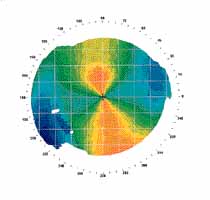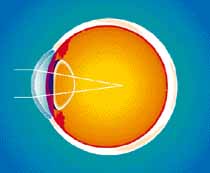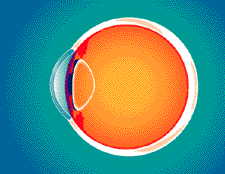A Few Bytes of Background Info

| Staring Into a Laser Beam A Few Bytes of Background Info |
 |
| --Scott Rainey | |
|
The cautionary pronouncements by well, everyone; including various optometrists, ophthalmologists, and tea leaf readers; caused me to not do Radial Keratotomy (RK) which is done with knives, (they call it slice-n-dice) in the mid-80's and wait for Photo Refractive Keratotomy PRK which is done with Lasers. By the time our ever-so-cautious FDA had allowed serious trials of PRK laser treatments, it was the early 1990's. The FDA in yet another of those courageous acts of bureaucratic CYA for which they are so famous, decided to wait a few more years before they allowed American Doctors to even begin testing these well known procedures to correct near-sightedness plus astigmatism. Since I have astigmatism, I therefore had to wait a lot longer. Although my surgeries occurred in May and July 1997, it was not then a commercial medical procedure, performed in a free standing clinic, but a proof-of-concept test under strict FDA scrutiny at a research university. One year later (May 1998) the same research test animal forms were filled out by a friend who went to another local clinic. The outside clinic used the OHSU operating room and laser machines. One reason ophthalmologists from all around the area use the laser at OHSU, is cost, and the operating room is a level 1000 positive air pressure clean room. Fortunately for me, Dr. Larry Rich M.D., and Dr. Scott M. Macrae M.D. at the Casey Eye Institute, a division of the Oregon Health Sciences University's Ophthalmology Clinic, (OHSU) are participants in these trials. They are also involved in testing these laser systems for the US-FDA. Dr. Rich and Dr. MacRae have been involved in US testing of leading edge corneal surgeries for most of their careers. They were on one of the first teams of US doctors to visit Soviet Russia to investigate RK. Dr. Rich is also co-editor of Principles and Practice of Refractive Surgery - ISBN 0-7216-6552-7 a 695 page, $275 textbook published in 1997. By the time PRK with astigmatism corrections (PARK) was approved for testing in the US, the rest of the world was regularly doing a new treatment called LASIK. LASIK (Flap-n-Zap) is a variation on PRK (Zap) that adds an extra step which shortens a portion of the healing time. That sounded like a good idea, so again I went on the waiting list. You guessed it. Testing of LASIK treatments for astigmatism were delayed more than a year after the FDA first allowed clinical trials of LASIK in the US. So after first getting my spot on the waiting lists in '91 I finally got to stare into the focus ring in May of '97. Many commentators have suggested that the FDA is a foot dragging batch of cowardly bureaucrats. Some suggest that the FDA's interminable foot dragging leads to thousands of early deaths and incalculable unnecessary suffering. It has been suggested that the only thing delaying US Ophthalmologists access to the first the RK suites, then PRK then LASIK and now the latest generation of machines is simple bureaucratic cowardice. Who knows? It is certainly a fact that the American public did not have much access to these technologies for the 10 years that the rest of the world had been enjoying them. My own opinion flip flops. Part of the FDA's charter is the safety of foods and medicines, and I'm certainly in favor of caution and safety, particularly when the subject is human eyes. However this technology could make a lot of lives a whole lot better, sooner, cheaper if the FDA were to facilitate faster testing. On the other hand, my thoughts from the dark days when both eyes were in the middle of healing is that our eyes are very important - we devote better than half our brains to seeing - and perhaps the FDA was right to do a go-slow on this technology. Now that I'm done healing; I want everyone in America to have access to this procedure and at 1/4 of what it cost me. I actively considered traveling to either Vancouver BC or Bogota Columbia (South America) for the LASIK procedure where clinics there have been doing tens of thousands of these procedures for many years. My own local Optometrist has been referring his patients to a clinic in Vancouver British Columbia. I had my original screening for PRK in '95. At last, in April of '97, I met with Dr. Larry Rich, Chief Investigator in laser corneal surgery at the Casey Eye institute at the Oregon Health Sciences University. He looked at my eyes and told me that he was not in favor of doing LASIK on me. I was a very low myope (about -1.00 with another -2.00 of astigmatism) so he strongly recommended that we do PRK with the new Nidek scanning laser. He said that he was 80% to 20% in favor of PRK over LASIK for me; which they tend to reserve for high myopes of about 6 diopters or higher. Dr. Rich had just done one of his own eyes which was -5.00 with PRK over LASIK, which is probably what helped me decide. After some initial resistance, I said: "Whatever you think best, Doctor," a phrase taught to me by an old friend who is himself an MD. Although it may seem that I'd wasted a couple of years, I'm not so sure. The Nidek Scanning laser is by all accounts, the best tool now in use in the USA. 
|
Home Page
|
 Focus problem in a nearsighted (myopic) eye |
 Animated GIF of PRK process (91k) |